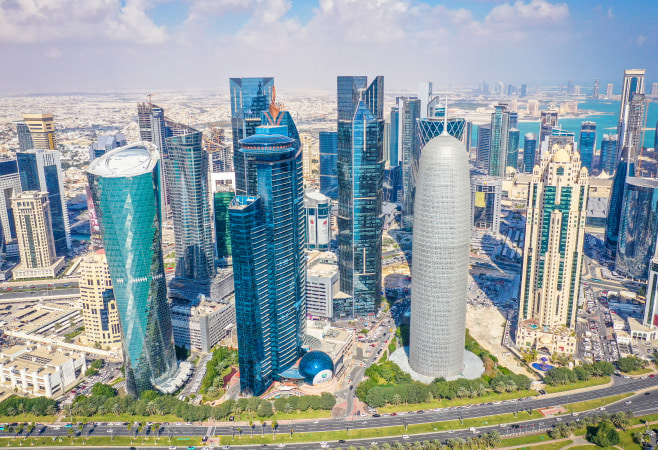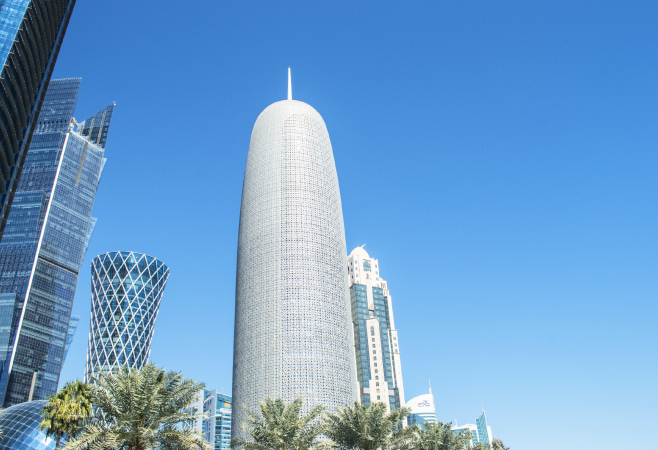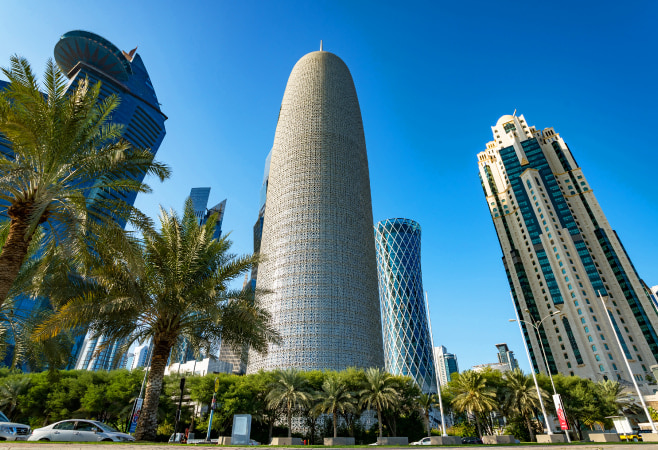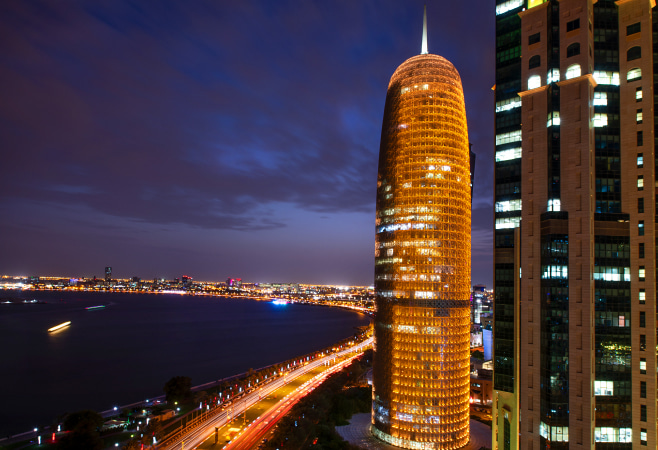Doha Tower - Burj Doha: Iconic Architecture in Qatar
Doha Tower - Burj Doha is a magnificent construction which is located in the center of the Qatari capital city. This cylindrical-shaped skyscraper was modeled by Jean Nouvel and the modern architecture is blended with the Islamic design features. Doha Tower with its distinctive front and green design characteristics has made it an icon in West Bay. Find out the reason this prize-winning building can be seen as a symbol of Qatar combining innovation, culture, and sustainable urban landscape.

Discover more details about Doha Tower – Burj Doha
Overview of Doha Tower (Burj Doha)
Burj Doha or the Tower of Qatar (also referred to as Doha Tower) is a 238-meter skyscraper building situated at Doha, the capital of Qatar in West Bay business district. This cylindrical tower was created in 2012 by a world-famous French architect Jean Nouvel. It has 46 floors above ground and 3 basement levels and it provides high priced office space.
Among the greatest highlights of Doha Tower is its complex exterior patterned after traditional Islamic mashrabiya. Not only adding aesthetic value but also shading towards the natural sun to cut the solar gain, the screen makes the whole building energy efficient.
The tower has been recognized internationally as an innovation of the design by the developer, H.E. Sheikh Saoud Bin Mohammed Bin Ali Al-Thani, and the builders Bouygues Batiment International. In 2012 it received the CTBUH Skyscraper Award as the best tall building in the Middle East.
Doha Tower is one of the most famous landmarks in Qatar, representing the integration of past and present engineering.

General information about Doha Tower (Burj Doha)
If you're fascinated by iconic skyscrapers like Doha Tower, don't miss the equally impressive Aspire Tower Qatar, a symbol of modern luxury and innovation in the heart of Doha.
Location of Doha Tower
Burj Doha or Doha Tower is a high-end skyscraper in the city of Doha, Qatar, which stands in the best area of the city, West Bay. It is a strategic place; the central business district in the city, with grandiose business constructions, upscale hotels, and representative offices located around it. The tower is sitting all erect on the part of Corniche Street, with fantastic views of the Arabian Gulf.
It is strategically located and accessible to Hamad International Airport and other major landmarks that include Souq Waqif, Katara Cultural Village and Museum of Islamic Art. The geographical position serves as added value to the Doha Tower as a prime destination to visit and do business by any foreigner.
Architectural design & features
A masterpiece of the mind of a distinguished French architect Jean Nouvel, Doha Tower gets the attention of admirers by its unusual cylinder-like shape and new concept of a façade. The tower stands 238 meters high consisting of 46 floors and combines modern technology and the traditional architecture of Islam. The most unique element of it lies in the rich screen façade (mashrabiya), the traditional Arabic motif, beauty, as well as the solar shield.
The layered structure of the façade minimizes reduced interior heat gain and instead embeds filtered sunlight. It makes the tower eco-friendly and highly climate-responsive. In contrast to the traditional skyscrapers, the chassis of Doha Tower has an exoskeleton of reinforced concrete of the diagonale type, which eliminates the need for internal columns and instead, allows the utmost flexibility of the interiors.
The building has high quality offices and special services that are designed to meet business needs of international standards. Doha Tower won the most coveted Aga Khan Award in 2012 because it is culturally and environmentally sound. This classic tower is another form of integration of art, culture, and sustainability in contemporary skyscraper architecture.

Architectural elements and features of Burj Doha
Alongside Doha Tower, the Aspire Tower Qatar also stands as a remarkable example of modern architecture, symbolizing Qatar’s rapid urban development and design innovation.
Structural specifications
Doha Tower – also known as Burj Doha – is a 238-meter-tall skyscraper with 46 floors above ground and 3 basement levels. Completed in 2012, it was Developed by Hamad Bin Saoud Group and owned by H.E. Sheikh Saud bin Mohammed Al Thani and designed by architect Jean Nouvel. The tower features a cylindrical structure with a total floor area of approximately 110,000 square meters, primarily used for commercial office space.
The tower's core structure is made of reinforced concrete, while its unique façade includes an external steel diagrid exoskeleton that eliminates the need for internal columns. This structural design provides greater flexibility in interior space planning and enhances the building's resistance to wind loads and seismic activity.
Doha Tower’s load-bearing system integrates both central core and perimeter support, enabling efficient vertical transportation and mechanical services. Its innovative design and engineering have earned it global recognition, including the Aga Khan Award for Architecture, highlighting its modernity, functionality, and cultural resonance.
While Doha Tower showcases modern architectural brilliance, the historic Barzan Tower Doha offers a glimpse into Qatar’s traditional defensive structures and cultural heritage.
Sustainability & environmental considerations
The inclusion of the principles of sustainable design used in Doha Tower (Burj Doha) represents the environmental concerns as well as cultural concerns. The most remarkable of its characteristics is the fanciful mashrabiya like skin, a contemporary version of the typical Islamic screens, being an interactive method of solar shading. It is able to cut direct sunlight through the windows and hence it helps to cut heat gains and cooling load demands of the building which can make a very big difference in terms of energy efficiency in Qatar environment in the hot desert climate.
The core and cylindrical shape of the building are also responsible for the passive cooling and moving the air around, which makes the energy consumption of the whole building even more efficient. The design utilizes high-performance glazing and environmentally friendly material which also promotes the sustainability agenda.
Doha Tower allows decreasing its impact on the ecology by fully utilizing the advanced methods of engineering construction and integrating regional moods in design as well as providing the high quality of interior atmosphere. Its sustainability strategy was also among the factors why the building became the winner of one of the noblest architectural prizes Aga Khan award in 2010 due to its cultural considerations and environmentally friendly innovations.

Green building features of Burj Doha
Awards & recognition
Doha Tower (Burj Doha) gained a lot of recognition in the international community with regard to its architectural diversity and cultural appeal. It especially earned itself the very honorable Aga Khan Award for Architecture in 2010. This award noted the capacity of the building to juxtapose the architectural design of the modern-day skyscraper and the traditional Islamic architecture by using the complex mashrabiya-inspired exterior, which is not only beautiful but has the green functional quality of the building.
Besides the Aga Khan Award, Doha tower is also an award winning tower that was listed by the Council on Tall buildings and Urban Habitats (CTBUH) as a major landmark in Doha. Its cylindrical shape, procurement of a central core, as well as good performance in a solar screen is what made it notable among other high-rise buildings as a ground-breaking construction.
Conceived by one of the most famous French architects Jean Nouvel, the tower remains as one of the architectural symbols of the Gulf region. Such awards prove that Doha Tower is a perfect mixture of innovativeness, sustainability, and cultural identification.
Cultural significance
Doha Tower (Burj Doha) is an impressive peculiarity of the Qatar cultural identity and architectural desire. The tower is successfully modern engineering combined harmoniously with traditional Islamic design, according to Jean Nouvel. It has an elaborate brise-soleil that is based on the design of Mashrabiya in its facade, which are considered a heritage of Qatar and also have a functional use of limiting solar heat gain.
While the tower does have a central core housing elevators and services, its floorplates are column-free thanks to the external diagrid structure, maximizing interior flexibility. Doha Tower is located in the West Bay commercial section; thus, it reflects a unique combination of modernity and cultural heritage in Qatar.
The tower won the Aga Khan Award of Architecture in 2013 and its design has received accolades for preserving the cultures related to cultural continuity amidst the fast pace of urbanization. Being one of the most recognised buildings of Doha, its masterpiece not only reinvents the skyline of the city but also enforces the commitment of the country to incorporate innovation with tradition in built up architecture.

The cultural importance of Doha Tower
After exploring the architectural wonders of Doha Tower, you might want to experience authentic Qatari cuisine at the Al Zubarah restaurant, known for its traditional flavors and cultural ambiance.
Tips you need to know before visit
Before visiting Doha Tower (Burj Doha), there are a few key things to keep in mind for a smooth and rewarding experience:
- Restricted access: Doha Tower is primarily an office building, so public entry is limited. Visitors should not expect a general observation deck or tourist facilities inside.
- Admire from the outside: Even without entering, the building’s stunning façade is best appreciated from the outside—especially at sunset when its mashrabiya-inspired skin creates striking shadows.
- Photography: Exterior photography is allowed and encouraged, but be respectful of signage and private property boundaries.
- Getting there: Located in West Bay, Doha’s business district, it is easily accessible by taxi or metro (DECC station is nearby).
- Dress code: As with all public spaces in Qatar, modest dress is recommended out of respect for local customs.
Although internal access is limited, the architectural and cultural significance of Doha Tower makes it a must-see when exploring modern Doha.
FAQs about Doha Tower - Burj Doha
Here are some frequently asked questions about Doha Tower – Burj Doha, covering its design, location, visitor tips, and cultural value to help you better understand this architectural landmark.
What makes the design of Doha Tower unique?
The design of Doha Tower is unique due to its cylindrical shape, absence of a central core, and a mashrabiya-inspired façade that blends traditional Islamic patterns with modern engineering to provide shade, reduce heat, and enhance energy efficiency.
When was Doha Tower completed?
Doha Tower was completed in 2012 after construction began in 2005. The project took approximately seven years to finish, and the tower officially opened the same year, marking its full readiness for use as a commercial office building.
Who owns and manages the tower?
Doha Tower is owned by H.E. Sheikh Saud bin Muhammed Al Thani. The building is managed by the Hamad Bin Saoud Group, which oversees its operations, maintenance, and leasing activities as a premier commercial office space in West Bay, Doha.
Has Doha Tower received any architectural awards?
Yes, Doha Tower received the “Best Tall Building Worldwide” award in 2012 from the Council on Tall Buildings and Urban Habitat (CTBUH). The award recognized its innovative structural design and cultural integration of traditional Islamic architecture with modern technology.
Can the public visit the tower?
Doha Tower is primarily a commercial office building and not generally open to the public. However, visitors can view and photograph its exterior. Access to the interior is typically restricted, unless arranged through tenants or during special events.
In conclusion
To sum up, Doha Tower is an outstanding feature of contemporary architecture, embodied in Islamic model, and an object that one must see as a part of the Qatari skyline. Tourists or business people should visit Doha tower which demonstrates the state of innovation and culture in Doha. Those who intend to travel to Qatar will find it easy to apply for an e-visa Qatar by going to the official site of Qatar Immigration Service so that they can have an easy entry process to witness iconic buildings such as the Doha Tower.
HOW CAN WE HELP?
APPLY WITH CONFIDENCE
|










